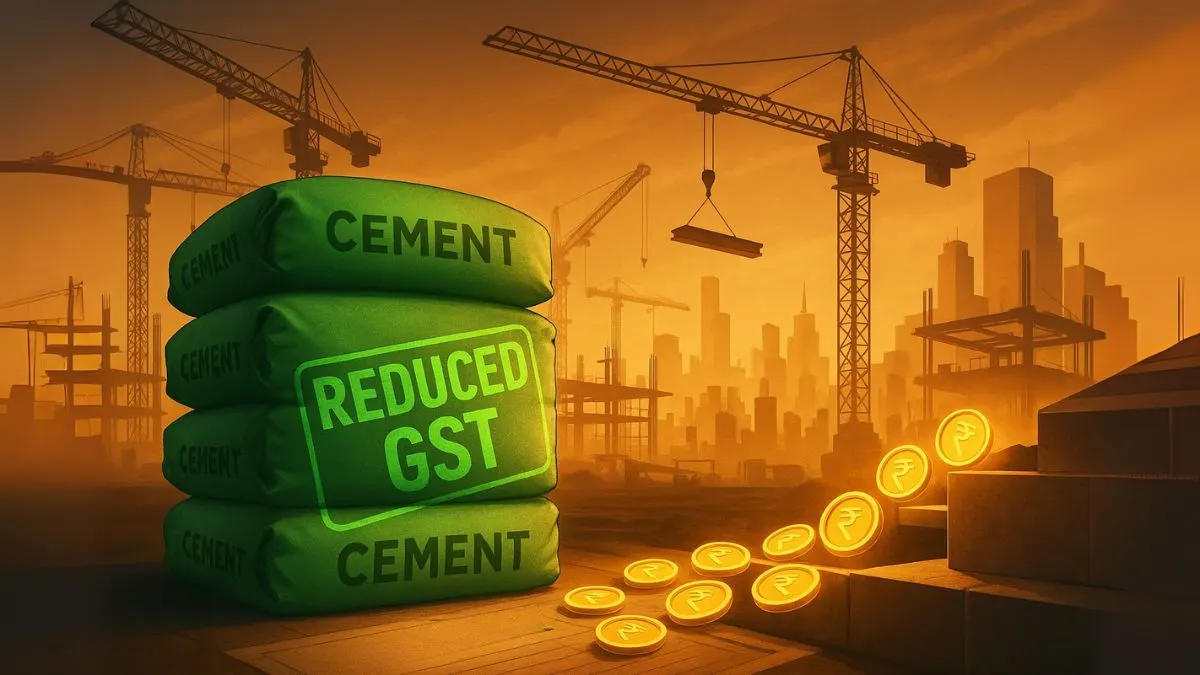
Cement is the backbone of India’s construction industry, powering everything from urban housing to rural development and mega infrastructure projects. Yet, for years, the sector has struggled under high tax burdens that raised costs for both businesses and end consumers.
Now, with the government announcing a GST cut on cement, industry players believe this decision will boost the sector and accelerate infrastructure growth. From real estate developers to cement manufacturers and contractors, the response has been overwhelmingly positive. The move is expected to not only revive demand but also generate significant economic momentum.
Why the GST Cut on Cement Matters
Earlier, cement attracted one of the highest GST rates in the 28% slab, making it expensive despite being an essential commodity. Builders often flagged high cement costs as a barrier to affordable housing and infrastructure growth.
By reducing GST, the government has addressed a long-pending demand. The GST cut on cement lowers costs across the construction value chain—benefiting manufacturers, developers, and consumers alike. The decision is being hailed as a reform that will bring lasting benefits to the economy.
Impact on the Construction Sector
The construction industry is the largest consumer of cement. Lower taxes will reduce overall project costs, allowing developers to launch more affordable housing projects."
Industry players point out that infrastructure projects, particularly in rural and semi-urban areas, will see faster execution. Road construction, public housing schemes, and urban development projects will all gain from the GST cut on cement, as lower material costs directly translate into lower budgets and faster approvals.
Housing and Real Estate: A Major Beneficiary
Affordable housing is one of the government’s biggest priorities under schemes like Pradhan Mantri Awas Yojana. Cement costs have long been a challenge in keeping housing prices within reach of middle- and lower-income groups.
With the new tax regime, housing developers will be able to pass on savings to buyers. This is expected to increase homeownership and drive demand in the real estate market. By cutting GST, the government is not only boosting construction but also helping families achieve their dream of owning a house.
Also Read: Relief for Value Chain but Anomaly in Garments Above ₹2,500
Infrastructure Growth to Accelerate
India’s infrastructure pipeline is massive, covering highways, metros, airports, bridges, and smart cities. These projects require millions of tonnes of cement every year.
The GST cut on cement makes these projects more financially viable. Industry experts believe it will encourage both public and private investment, accelerating India’s pace of infrastructure development. The multiplier effect is significant—more infrastructure means better connectivity, more jobs, and stronger economic growth.
Industry Reactions
Cement manufacturers and construction associations have welcomed the reform. According to industry players, the high tax rate had discouraged demand growth despite India being the second-largest producer of cement globally.
Now, with GST rationalisation, producers expect demand to rise steadily. Some industry voices suggest that the government’s decision will also reduce the prevalence of unorganised sales, bringing more compliance into the sector.
Challenges the Sector Faced Before GST Cut
Before the revision, the cement industry dealt with:
- High GST rate at 28%, raising costs.
- Pressure from developers to cut prices.
- Stalled infrastructure projects due to budget overruns.
- Weak rural demand because of high construction costs.
The GST cut on cement has eased these pressures, making the outlook more positive for all stakeholders.
Economic Implications of GST Cut on Cement
The decision carries wider economic benefits beyond the cement industry itself:
- Lower construction costs – Direct benefit to housing and infrastructure.
- Boost to employment – Construction jobs will rise as projects pick up speed.
- Stimulus for allied industries – Steel, tiles, paints, and logistics will also benefit."
- Increased tax compliance – Lower GST reduces evasion and widens the tax base.
Thus, this move is expected to contribute meaningfully to India’s GDP growth.
Also Read: Bata’s Big Step: GST Cuts Now Mean Cheaper Footwear for You
Comparing Old vs. New GST Impact
|
Category |
Old GST Rate |
New GST Rate |
Impact |
|
Cement (all categories) |
28% |
Reduced (5–18% depending on slab) |
Lower construction and housing costs |
|
Housing projects |
High tax burden |
Reduced costs |
Affordable housing more achievable |
|
Infrastructure projects |
Stalled or delayed |
Faster execution |
Accelerated infrastructure growth |
This shows how the GST cut on cement changes dynamics across multiple segments.
Boost for Rural and Semi-Urban Construction
While urban housing projects gain visibility, the real impact of lower GST will be felt in rural and semi-urban areas. Families building their own homes will find cement more affordable. This will boost rural demand and stimulate local economies.
Infrastructure projects such as rural roads, schools, and healthcare centers will also progress faster, improving the quality of life in smaller towns and villages.
Sustainability Angle
Cement is one of the most resource-intensive industries, and high costs often limited the adoption of green construction practices. With lower GST, there is an opportunity for companies to invest more in sustainable alternatives like blended cements and eco-friendly materials. This aligns with India’s climate goals and ensures long-term industry resilience."
Looking Ahead
Industry experts believe that the GST cut on cement will drive a new wave of growth. With housing, real estate, and infrastructure sectors benefiting directly, the demand for cement will rise.
Manufacturers may also explore expansion plans and capacity additions to meet this surge. Government-led initiatives like Housing for All and National Infrastructure Pipeline will get a timely push, ensuring long-term stability for the cement sector.
Also Read: GST Slash on Instant Coffee: Your Morning Cup Just Got Cheaper
Final Thoughts
The GST cut on cement is being hailed as a reform that will boost the sector and accelerate infrastructure growth. From affordable housing to mega infrastructure projects, the benefits are wide-ranging. Industry players believe this decision is a turning point that will stimulate demand, encourage compliance, and generate jobs.
By lowering costs for both consumers and developers, the government has not only supported the cement industry but also strengthened India’s growth story.











